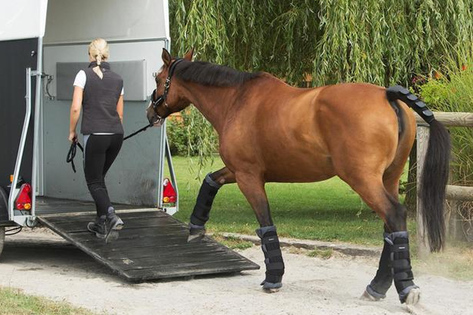
Are You & Your Horse Ready For Bitting Advice? The Steps You Need To Consider First
Equestrian Advice & Guides All Disciplines
Build your business profile for FREE and expose your services to thousands of potential clients!
Create my profile now!
Livery yard owners taking deposits from their clients is now becoming commonplace, but many yard owners are still cautious as to the implications, and that such requests may put off potential clients. Here we explain the two types of deposit, and how best to implement them on your yard.
The main type of deposit is the security deposit taken upon arrival of a new livery. This is taken as a security bond, similar to that with property or vehicle rental. In the event that a livery client gets into debt with your services, causes damage or leaves without notice, then this payment - or a proportion of it - is retained to cover these losses. In the event that a livery stays with you, passes without issue and they leave on good terms having served notice, then the security deposit is returned in full.
The amount of the security deposit will depend upon the services you provide and the packages you offer, and should be taken per horse, not per client. Ideally - to cover shortfall of notice - the deposit sum should equate to at least a month’s livery costs, with a higher sum of around £200 being the standard if your livery costs are less than this. However, for those liveries charging a higher rate for more inclusive services, then this could be quite a substantial amount. In which case you need to consider and calculate a reasonable sum to charge as a deposit, which should be equal to the cost of the empty stable - or the DIY equivalent - for the months’ notice.
As well as leaving without serving notice or paying short of money owed, you also need to consider the different ways in which a livery could cause you losses beyond the standard ‘wear and tear’ expected during their stay. There could be damages to paddocks, fencing, stables, fixtures and fittings, schooling facilities and equipment, horse owners that may leave and not clean out their stables or clear their spaces as requested, plus of course the less common occurrence of thefts upon departure, so the security deposit should be a reasonable amount to reflect the possibility of any of these occurrences. Yard owners will often shy away from taking deposits, yet when they are left in situations like those detailed above, they find themselves at a financial loss and often have to resort to trying to retain the horse, horse passport or equipment until the horse owner pays up, pursue the other party through the small claims courts, or more often than not, just write off the losses. The introduction of security deposits protects against such losses with little effort on your part.
You can easily incorporate a section for deposits into your livery contract, clearly laying out the terms and reasons for their requirement and making it a contractual part of your livery agreement. The deposit payment should be taken along with the first month’s livery payment, which should also be made in advance. Example wording for such a clause in your livery contract can be found on point 3 of our Template Livery Contract. The security deposit is retained by the yard owner until such time as the horse owner departs and the livery contract is terminated. If serving notice to the livery, our Template Notice Letter confirms to them the notice terms, and what happens regarding the return of their deposit.
If the departure passes without issue then the deposit is returned in full. Some yard owners will choose to deduct this from the final invoice amount, but it’s not advisable to do this in case there are issues discovered once the horse has left, such as stables left dirty or damage found. It’s advisable for the payment of the final invoice to be kept completely separate, with a guarantee that the security deposit will be refunded within 7 days of their departure following settlement of their final invoice and confirmation that all has been left in good order on the yard. In the event that all or part of the security deposit needs to be retained to cover any losses, this should be communicated to the client in writing with a breakdown of the costs to be covered, and any remaining balance returned. For example, if they do not clean their stable as required before departure, you can charge a relative nominal sum to do this for them - i.e. £50. When you refund the remainder of their deposit, you simply state the amount retained, and what this is for. It is advisable to take photos beforehand of any circumstances that warrant retention of security deposit so that these can be sent to the client if necessary.
But what about if they leave you with losses exceeding the security deposit? If a livery client builds up debt and then leaves, sometimes without their months’ notice as well, you could find the amount of loss or debt far exceeds the security deposit. In such cases you are still within your right to reclaim any losses exceeding the security deposit via the small claims court. This is one of the reasons it is so important to have your paperwork in order - including client’s records - and ensure you see proof of their ID and address upon arrival at the yard. Whilst this may seem extreme, this is the only way you will be able to recoup any remaining losses. Upon arrival of any new client, you should send them a Welcome Letter and Checklist, and ensure that they provide you with the requested details within 7 days.
Now onto the second type of deposit, this is a holding deposit for stables until such point as a livery is able to join you. You will often find a new client is eager to join your yard but has to serve notice at their current yard, perhaps buy their horse, or wait for other circumstances to change before they are able to arrive with their horse. Many yard owners will hold stables free of charge as a gesture of goodwill, but often they are let down by the new client who simply stops contact or never arrives, so the yard owner has been left with an empty stable that could have had a paying client in it for some weeks. The other reason a holding deposit may be required is if you have an existing client who leaves with their horse for study or work reasons, or to send their horse off for schooling livery or suchlike, and wishes to secure their stable whilst absent.
The best way to do this is to take a holding deposit from potential clients. Anyone serious and committed to joining your yard, or an existing livery wanting to keep their stable whilst vacant, should willingly pay a contribution to hold that space. You need to consider that whilst being held for a client, your stable could be full with a client who has already arrived and is paying the livery in full. It is recommended to have the holding deposit as the full rate for DIY, and a proportionate rate for any serviced packages, bearing in mind there will be no care or provision costs for the horse until it arrives.
You can choose whether they pay a fixed holding sum - which can be non-refundable or deducted from their initial livery payment - or whether they pay a retaining fee per week to hold the stable. You should agree a fixed duration for the initial reservation, with a review near the end of this period when you can choose to extend or terminate the reservation. Confirmation of the stable reservation can be sent to the potential client using our Template Holding Deposit Letter.
The more frequently yard owners seek deposits from clients, the more this will become expected as an industry standard. Once you introduce the process of requesting deposits you should do this for all clients, and seriously consider whether a potential client who’s not willing to pay a security deposit is right for your yard. After all, this is them showing their commitment to you, and is a simple and effective way to protect yourself from losses.
LiveryList is the UK’s #1 Livery Yard Directory and Yard Owner Resource, and has a huge number of template documents and resources available for yard owners on the LiveryList Yard Owner Hub, including a specific section on Livery Contracts and Client Administration.
With hundreds of horse owners looking for a new yard every week, yard owners can advertise their Livery Yard and their vacancies on LiveryList from just £12 a year.
LiveryList also runs the Livery Yard Owners UK- Discussions and Advice Facebook group. A closed group especially for verified owners across the UK, it is a friendly and welcoming group allowing yard owners to discuss and share advice, as well as network with other yard owners in their area.

